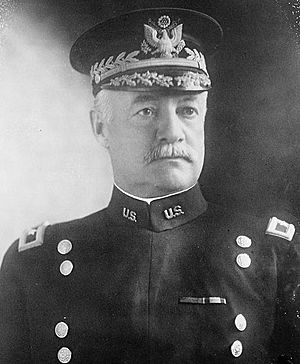Hunter Liggett facts for kids
Quick facts for kids
Hunter Liggett
|
|
|---|---|

Liggett as a brigadier general
|
|
| Born | March 21, 1857 Reading, Pennsylvania |
| Died | December 30, 1935 (aged 78) San Francisco, California |
| Buried | |
| Allegiance | United States |
| Service/ |
United States Army |
| Years of service | 1879–1921 |
| Rank | Lieutenant General |
| Commands held | Third United States Army First United States Army I Corps 41st Infantry Division Philippine Department |
| Battles/wars | Indian Wars Spanish–American War Philippine–American War World War I |
| Awards | Army Distinguished Service Medal Legion of Honour (France) Croix de Guerre (France) |
Hunter Liggett (born March 21, 1857 – died December 30, 1935) was an important officer in the United States Army. He served for 42 years, from the time of the Indian campaigns all the way to World War I. Liggett was also known for finding places in the Philippines where enemies might try to invade, especially a spot called Lingayen Gulf. This information was later used during World War II.
Contents
Early Life and Military Career
Hunter Liggett was born on March 21, 1857, in Reading, Pennsylvania. He studied at the United States Military Academy in West Point, New York. After graduating in 1879, he became a second lieutenant.
Liggett was first assigned to the 5th Infantry. He served in different parts of the United States, including Montana, Dakota, Texas, and Florida. During this time, he was promoted to the rank of captain.
Developing Leadership Skills
Liggett gained valuable experience as a military leader. He served in the American West during the American Indian Wars. He also fought in the Spanish–American War and the Philippine–American War.
In 1907, he took charge of a group of soldiers in the 13th Infantry Regiment. From 1909 to 1914, he was a student, teacher, and then president at the United States Army War College. He became a brigadier general in 1913.
Studying Invasion Routes
While in the Philippines, Liggett helped plan a special study in 1914. This study looked at possible places where enemies might invade the island of Luzon. His assistant, Captain George Marshall, helped him with this important work.
They found that the most likely invasion route would be through the Lingayen Gulf. They also realized that stopping such an invasion would be very hard unless the U.S. greatly increased its army and navy forces there. Years later, in 1941, the Japanese army invaded through the Lingayen Gulf. The United States also used this route when they invaded in 1945.
World War I Service
Liggett showed great skill in leading brigades in Texas and the Philippines. Because of his success, he was promoted to major general. In April 1917, he was chosen to command the 41st Division.
This division served in France as part of the American Expeditionary Force. When his division was later reorganized, he took command of I Corps.
Leading Major Offensives
Under Liggett's command, the I Corps took part in important battles. These included the Second Battle of the Marne and the reduction of the Saint-Mihiel salient. In October 1918, he became commander of the First United States Army. He was promoted to lieutenant general in the national army.
He led the final parts of the Meuse-Argonne offensive. This was a major battle that helped end World War I. He continued to lead the pursuit of German forces until the armistice, which was the agreement to stop fighting. After the war, he commanded the Army of Occupation. Liggett then returned to his permanent rank of major general and retired in 1921.
Life After the War
After retiring, Hunter Liggett wrote a book about his experiences during the war. It was called A.E.F.: Ten Years Ago in France and was published in 1928.
In 1930, a new law allowed World War I generals to retire at the highest rank they had held. Because of this, Liggett was promoted to lieutenant general on the retired list. He passed away on December 30, 1935, in San Francisco, California. He is buried at the San Francisco National Cemetery. His grave is in the officers section 3, plot 1.
Honors and Awards
Hunter Liggett received many awards for his service.
Military Honors

- American Awards
| Army Distinguished Service Medal | |
| Indian Campaign Medal | |
| Spanish War Service Medal | |
| Philippine Campaign Medal | |
| World War I Victory Medal | |
| Army of Occupation of Germany Medal |
- Foreign Awards
| Légion d'honneur (France), class of Commandeur | |
| Order of Leopold (Belgium), class of Commandeur | |
| Order of Saints Maurice and Lazarus (Italy), class of Commendatore | |
| Croix de Guerre with palm (France) |
Other Honors
A United States Army base on California's central coast was named Fort Hunter Liggett in his honor.
Liggett Hall is a large building at Fort Jay on Governors Island in New York Harbor. It was built in 1930 and was once thought to be the biggest building constructed by the U.S. Army. It was later surpassed by the Pentagon.
The USS Hunter Liggett was a passenger ship. It was given to the Army and renamed Hunter Liggett in February 1939. The ship carried soldiers and supplies. In 1941, it was given to the Navy and later reclassified for the United States Coast Guard.
Images for kids


